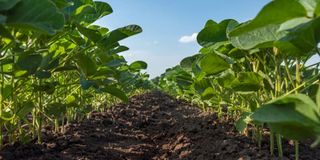Farmers embrace soya beans in poverty fight

Some of the soybean varieties include Hi|I, Sable, Duicker, EAI 3600, Composite, Red tanner, Black Hawk, Perry 41, SC-1, Nyala and Gazelle. PHOTOS/INTERNET
What you need to know:
- About 88.3 percent of the households in Bukedi depend on subsistence farming.
Farmers in Bukedi Sub-region have embraced the growing of soya beans to fight household poverty.
For decades, the sub-region had been known for growing cotton but the trend has changed due to, among other factors, lower prices compared to soya beans.
For instance, a kilogramme of soya beans is sold between Shs3, 000 and Shs5,000 while cotton prices are unpredictable ranging between Shs800 and Shs1,000 per kilogramme.
Mr David Kawu, a resident of Kabuna Sub-county, abandoned cotton growing because it is labour intensive and less profitable compared to soya beans.
“In the previous season, I harvested 500 kilogrammes of soya beans and earned Shs2.5 million. If I had planted cotton, I would not have fetched Shs500,000. Cotton growing is just a waste of time and resources, “he said.
Another farmer from Budaka Sub-county, Mr Stephen Kisale, said he earned Shs6.5 million after harvesting and selling 1.3 tonnes of soya beans in the previous season.
“I don’t regret embracing soya bean cultivation because if I had planted cotton, I wouldn’t have got that money,” he said.
The North Bukedi Cooperative Union said production of cotton has been declining since 2003, especially in Bukedi, due to poor quality seeds and low prices of the traditional cash crop.
Ms Florence Twanza, a resident of Budaka Town Council, said: “The cultivation of soya beans will drive people out of poverty because cotton is labour-intensive and has low profits.”
About 88.3 percent of the households in Bukedi depend on subsistence farming.
The National Development Plan III poverty reduction projections for the sub-region will be 25.8 percent by 2025.
Mr Asani Daki, a resident of Tademeri Sub-county, said the soils in Bukedi also favour soya beans growing, compared to other crops.
“Our soils are good for soya bean growing that is partly the reason farmers are earning more from it,” Mr Daki, said.
Mr Ibrahim Mulepo, the chairperson of Budaka District Soya Growing Cooperative Ltd, said farmers have shunned cotton growing because they have remained poor.
“Cotton had only contributed to their [farmers’] prolonged life in poverty, “Mr Mulepo, said, adding that the cooperative so far has 2,500 farmers
Mr Stephen Nyende, the secretary of the cooperative, said in the previous season, they harvested 8 tonnes of soya beans and hope for higher yields.
The North Bukedi Cooperative Union Chairman, Mr Farouk Gundi, however, said that efforts are being made to revamp cotton growing by offering better prices and incentives to farmers.
“As a union, we are not just sitting but making efforts to have farmers turn back to cotton growing, which used to be a lucrative enterprise,”Mr Gundi said.
Poverty
•In June 2021, Uganda National Household survey 2019/20 report by the Uganda Bureau of Statistics
showed of the 8.5 million people living in poverty, most resided in Busoga, Bukedi, Acholi and Kigezi regions.
•The report said the number of people living under poverty in Busoga stood at 14 percent followed by Bukedi region at 10.4percent and Acholi sub-region, which stood at 10.3 percent




